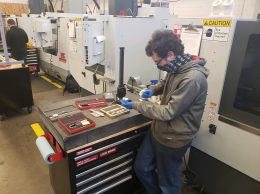
An in-bottle wine aerator was among the inventions proposed by Cal Poly engineering students at a Nov. 21 expo. (Stephen Nellis / Business Times photo)
An in-bottle wine aerator, a Spider-Man-like robot that can climb walls and a peach pit detector were among the projects on display at Cal Poly San Luis Obispo’s mechanical engineering expo on Nov. 21.
Twice a year, graduating mechanical engineers partner up with corporate sponsors to solve real-world problems for the companies, occasionally spinning their ideas off into companies of their own. Thirty-one student teams completed projects this semester, with tri-county sponsors such as Pacific Design Technologies, Sunrise Arts, Cambria Pines Inn and Weatherby taking part.
A team called PKP Designs consisting of Patrick Lowry, Paul Woolworth and Kevin Kesler worked with San Luis Obispo-based Capital Cultivators to design an in-bottle wine aerator. Wine aerators help work air into red wine, causing chemical reactions that many wine drinkers feels unlocks the full potential of the wine. Most devices are designed to be fit into a bottle neck after the wine is uncorked, but the PKP team worked on an aerator that would be built in when the wine is sold.
“It has the same type of aeration mechanism, but it’s already in the bottle under a regulator screw cap,” Kesler told the Business Times.
To test its design against existing aerators on the market, the team measured dissolved oxygen and letting a scientific approach determine the optimum shape. “Sometimes if you make it have a loud wooshing sound, people think it aerates a lot, even if it doesn’t,” Kesler said. The team used 3-D printers to rapidly make test prototypes, and has taken steps to start patenting the design. “This project wouldn’t have been possible five years ago,” Kesler said.
Another team consisting of Kelvin Lei, Eric Mar and Cameron Venancio is creating a startup called Aerobotik around a robot it created called Otto. The team worked with Washington-based Electroimpact, an aerospace company. Electroimpact makes robots that cut sheet aluminum at aircraft factories. Currently, the robots whiz around a fuselage by gliding along tracks above the plane body. Those tracks take are costly and time consuming to set up.
“They came to us and said, we want to nix the tracks. Build us a machine that can climb walls and ceilings,” Venancio said.
The team/s response was Otto, which uses bellow-like suction cups to hold tight to surface and slide a long. It can support the weight of an engineering student hanging from the ceiling. (Click here to watch a video.)
Many teams built testing equipment for their corporate sponsors. The team of Benjamin Canfield, Trevor Foster and Wil Meijer worked with Paso Robles-based Weatherby, a well-known maker of big-game hunting rifles. In the shooting sports world, Weatherby is famous for its powerful magnum rifles, which kick the shooter hard. But just how hard is still somewhat subjective, which the team hoped to solve with a testing machine. “They didn’t have a scientific way of testing the recoil of their guns,” Canfield said.
Some teams brought together Cal Poly’s traditional strengths in engineering and agribusiness. Working with Clovis-based Wawona Frozen Foods, a team made up of Rick Hayes, Colby Lippincott, Hamilton Little and Elliot Wenzel came up with a machine to detect any pieces of peach pit that might be left over after peaches have been cleaned for processing. Even a tiny piece of pit can cause big problems with peaches are packed or blended into other foods such as yogurt.
The system uses a series of needles attached to a sensor bed to probe the peach in a process that the team said didn’t affect flavor in a blind taste test. “If any of the needles hit a pit or a piece of metal that’s harder than the peach around it, it triggers the pressure sensor,” Hayes said.
Many projects were aimed at harnessing innovation to help the disabled or impoverished. One team consisting of Nick Fuller, Jason Morgan and Darren Sholes focused on making an extremely low cost solar concentrator to help use for cooking in the developing world. Solar concentrators collect and focus sunlight to create heat without burning fuel, but their precision design makes them cost thousands of dollars.
The team came up with a design whose plans can be downloaded for free from the Internet and that can be built with hand tools and common materials at a cost of about $141.
“There are a lot of problems with burning solid fuels in the developing world. People are burning wood and dung indoors, which can lead to lung and eye problems,” Sholes said.
The company fell short of its goal of a system that cost less than $100. But by using sophisticated mathematical modeling, the team created a simplified shape that gets most of the benefits of an expensive solar concentrator without as much of the complexity.
“We’re probably not quite as efficient as those, but for cooking it’s useable,” Sholes said. “Our end goal is to create a manufacturing guide that anyone anywhere can read for free.”
VIDEO:
Watch Otto the wall-climbing robot in action.






 Print
Print Email
Email

















